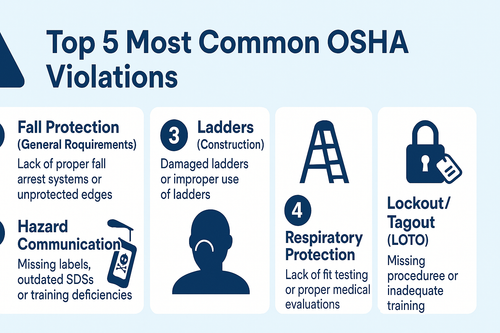
OSHA 2025: Key Changes Safety Professionals Must Know
Every year, the Occupational Safety and Health Administration (OSHA) revises its standards and enforcement priorities. These updates are not just about regulatory compliance. They reflect emerging risks, evolving technologies, and shifts in how we think about worker health and safety. For safety professionals, understanding what has changed in 2025 is essential for staying ahead of inspections, avoiding penalties, and most importantly, protecting people on the job.
One of the most significant areas of focus this year is heat-related illness. With more frequent extreme weather, OSHA has expanded its National Emphasis Program on heat hazards. Inspectors are now taking a closer look at outdoor and indoor workplaces during high-temperature events. Companies are expected to have real-time temperature monitoring in place, as well as clear procedures for hydration, shaded rest breaks, and emergency response. This isn’t just a best practice anymore. It is becoming a standard expectation in OSHA’s field enforcement.
There has also been a notable shift in how penalties are applied. OSHA has increased the maximum fines for both serious and willful violations. Employers with repeat violations are especially under the microscope. If a company has been cited for a specific hazard before, they can now expect a more aggressive follow-up and significantly higher penalties. This change is aimed at encouraging sustained compliance, not just reactive fixes after citations.
Construction and manufacturing continue to be priority industries. OSHA has renewed emphasis programs that target common risks in these sectors, such as falls, trench safety, and machine guarding. What’s new is the data-driven approach. OSHA is using regional injury and fatality trends to decide where and how to focus inspections. That means safety professionals should be paying attention not only to federal standards but also to state-level data and regional initiatives that may trigger an inspection.
Another important development in 2025 is OSHA’s stronger stance on whistleblower protections. The agency has updated its guidance to make it easier for workers to report unsafe conditions without fear of retaliation. Employers are expected to create and maintain confidential reporting channels and take documented action when safety concerns are raised. Failing to do so could now result in enforcement even if no physical hazard is found.
Finally, OSHA is investing in digital tools to support its mission. This includes self-assessment resources, electronic reporting enhancements, and pilot programs for remote inspections. While these tools are designed to improve access and efficiency, they also increase the agency’s visibility into workplace safety practices. For organizations, this shift is an opportunity to modernize internal safety systems and streamline compliance reporting.
OSHA’s updates for 2025 signal a broader movement toward accountability, transparency, and proactive risk management. For safety professionals, the message is clear: stay informed, stay prepared, and keep investing in continuous improvement.
If you're looking for a structured way to apply these updates in your workplace, consider joining our course on OSHA Compliance Updates and Enforcement Trends in 2025 to earn CEU points for recertification. Staying current is one of the best ways to keep your workforce safe and your business compliant.


